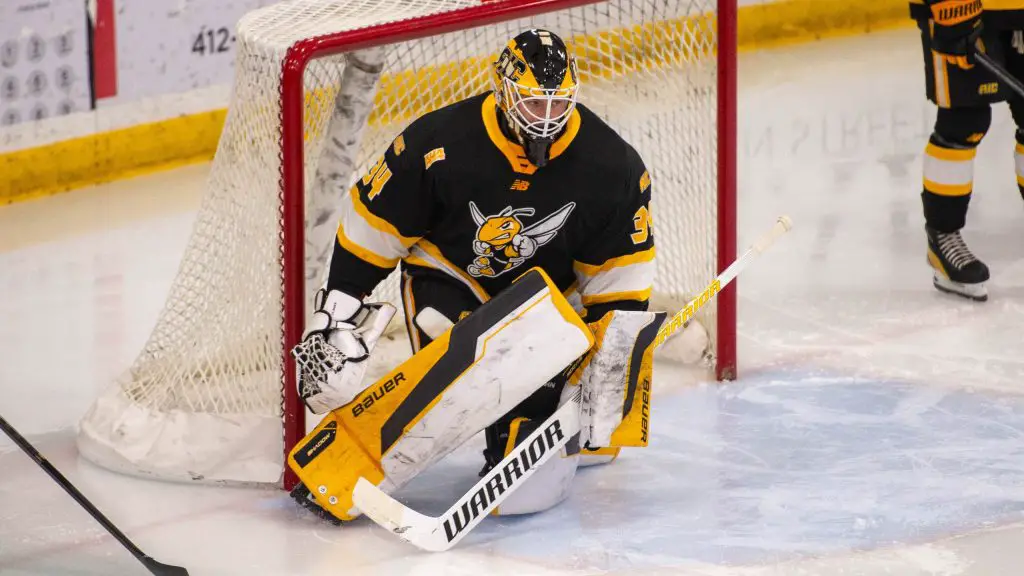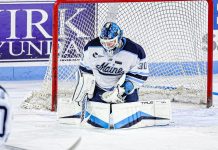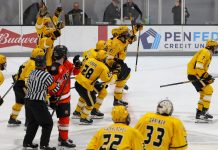
Each week during the season, we look at the big events and big games around Division I men’s college hockey in Tuesday Morning Quarterback.
Jim: Well, Ed, we’ve officially reached the halfway point of the college hockey season, even if most of the teams out there haven’t played half of their collective games.
This seems like a good time to re-hash some of the biggest storylines from the first half of the college hockey season, and to no one’s surprise, the biggest story thus far seems to be the NCAA’s vote to allow players from the Canadian Hockey League – a.k.a. Major Junior – to play in college hockey.
To date, I actually don’t feel like the collective college hockey world has felt the seismic shift that this legislation should bring. In reality, we won’t hear about most of the related commitments from this decision until the offseason.
Do you have a feel for how much impact this will have?
We have speculated about it, and realistically the impact should hit American junior leagues the most. I am most interested in seeing the number of signings from leagues like the North American Hockey League and other smaller regional junior leagues. Will those numbers be significantly less than previous years?
What are your thoughts?
Ed: I think there will be a domino effect on the NAHL, and USA Hockey has met with that league and the other two it sanctions, the USHL and the NA3HL, to discuss what’s next. The same situation applies for Canadian leagues overseen by Hockey Canada, plus the independent BCHL.
However, I’m hard-pressed to give you a real prediction.
I do think it’s going to push some players who might have gotten a D-I scholarship to a D-III school. The signs of that are already happening.
Major Junior eligibility in the NCAA is limited to Division I, so anyone who plays college hockey in the U.S. from the CHL will have to go to the 63 programs that will be in D-I next season.
So far we’re not only seeing recruits who have transferred or are transferring to Major Junior from the USHL and BCHL, but also players who are being recruited who would not have had the opportunity to play college hockey. Each one of those players is going to bump someone who took what they thought was the only route for college hockey. And that’s going to hurt.
The problem is exacerbated by what appears to be a pending limit on roster sizes as a result of the upcoming House v. NCAA settlement, which is our second major storyline.
Jim: I think the House v. NCAA settlement is maybe the most concerning storyline for college programs.
Increasing the number of scholarships to 26 may be the best thing to happen to college hockey in a long time, but I also see limiting roster sizes to that same number of 26 players is very shortsighted.
The reality is that, while some programs can survive with 26 players, there isn’t a desperate need to cap the number of players that a school can enroll.
Think of this scenario for a university: you have a sport that today gives 18 scholarships and might have 30 on their collective roster. That school is getting the cost of 12 players enrolling in their school.
Now tell that same school you have to increase your scholarships by eight and you can no longer enroll those bonus students that boost the bottom line.
Those are all horrible formulas for some institutions. We are already seeing the issues at American International, a program that has become a mainstay in the AHA.
Ed: The situation at AIC is by far the saddest storyline for me so far this season.
Perennially an underdog with an underfunded program, American International brought in alumnus Eric Lang in 2016 after the retirement of longtime coach Gary Wright and committed resources to improve the Yellow Jackets. In Lang’s third season, AIC won the Atlantic Hockey regular season and championship and repeated the feat in 2021 and 2022. The team’s 2019 upset of No. 1 seed St. Cloud in the NCAA regionals and images of the celebration in the locker room are some of the great moments for small schools in D-I hockey.
Adding insult to injury was the abrupt cancellation of AIC’s game against Holy Cross on Dec. 7, 2024 because the Yellow Jackets did not have a healthy goalie to start the game.
Lang has been an advocate for larger rosters and cited the deep bench at AIC for that team surviving to the Atlantic Hockey championship game last season through a stretch that would’ve resulted in forfeits because of a plethora of injuries.
Sadly, AIC’s situation with injured players and a tight financial situation at the college highlights the possibility of haves and have nots in D-I hockey.
A report in Canadian media last week suggested that an OHL player might have been offered more than $1 million to leave Major Junior and sign with a top college program. What’s the scuttlebutt on that?
Jim: The story you reference was Boston College potentially paying an OHL player (reportedly Saginaw Spirit standout and probable 2025 first-round pick Michael Misa) $1 million or higher, but their athletic director Blake James emphatically denied this money is coming from BC.
By who? I can assure you, it is not Boston College. OHL Player Offered North of $1 Million To Play For Boston College https://t.co/7Dn2joZAQE
— Blake James (@BCBlakeJames) December 13, 2024
Regardless, one has to wonder when a storyline like this will become a reality.
If you can recruit a player and your competitive edge is money, why wouldn’t you leverage that. All of the provisions that were once in place have basically disappeared.
I always had concerns that one major donor could influence the recruiting process. We are so far beyond that now. And while the student-athlete certainly benefits, I can’t help but think that the overall college athletics landscape is about to suffer.
Do I sound like a curmudgeon at this point?
Ed: Maybe. But I’ve been accused of being a curmudgeon myself.
Money, in the form of name, image, and likeness (NIL), has been the catalyst for all of things people are complaining about.
Without NIL money, we don’t have the transfer portal issues. That came about because limiting transfers was seen as a restraint of trade and resulted in a lawsuit from 10 states, D.C., and the United States Department of Justice. Back in May, that resulted in a settlement with the NCAA that permanently ends previous restrictions on transfers.
Without NIL money, we don’t have the House v. NCAA settlement, which will include student-athletes getting revenue sharing and which will set boundaries for rosters and scholarships all across college athletics.
Without NIL money, we don’t have the lawsuit against 10 universities and the NCAA calling the restriction of Major Junior players a restraint of trade. And that’s especially significant because NIL bucks can dwarf the very modest stipends in the CHL and the arguments about amateur status have become a joke.
The old saying is that you can’t put the toothpaste back in the tube. Your guess is as good as mine where things go from here. But let’s hope the upheavals settle down.
Optimistically, schools of the right size can avoid the big money issues of Power 5 conferences and launch new programs. Pessimistically, all the money could chase programs out.
I’m opting to be a glass half-full kind of guy and I’m bullish on college hockey, especially after we get through the uncertainty of this current climate.


